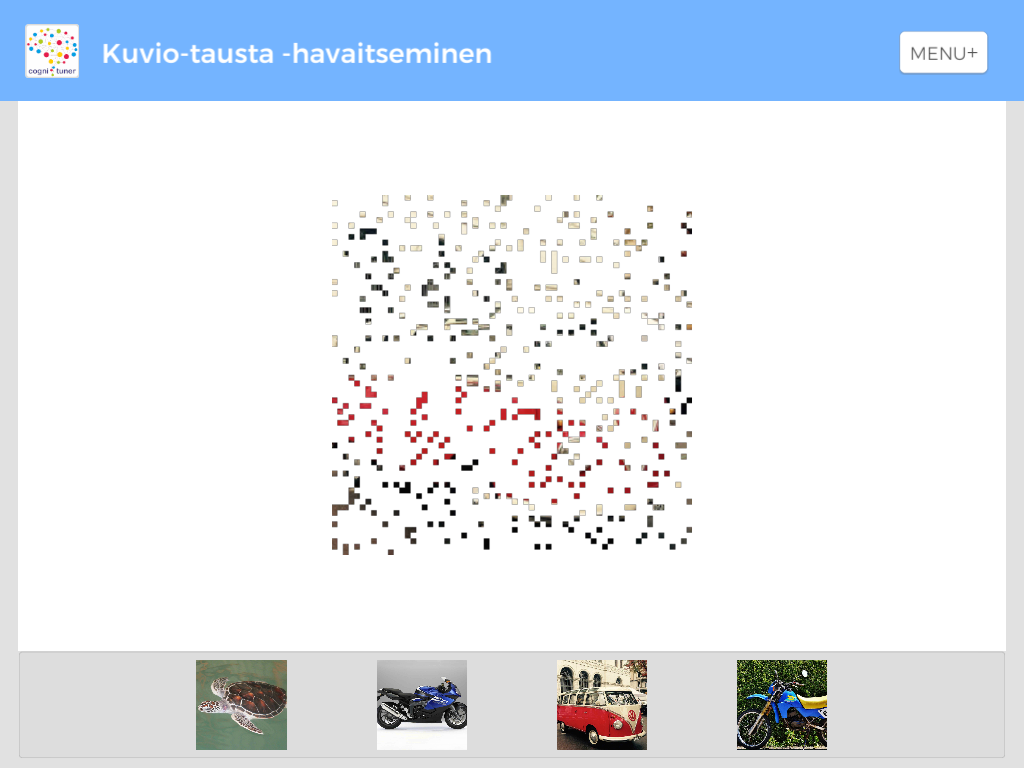Cognituner is divided into four modules according to the key domains of cognition: attention, memory, visual perception and executive functions.
Attention
Attention is a basic prerequisite for cognitive functions and its disorders affect the effectiveness of other cognitive functions. Attention is closely related to the state of alertness, purposefulness, and the state of emotion and motivation. Attention can be distinguished between automatic orientation reactions and intentional orientation. Because the amount of information that can be processed in the mind is limited, it is important to be able to focus on the information relevant to the task and on the time required to complete the task. Attention can be divided into subdomains: focusing, sustaining, and dividing /alternating. Attention is also a prerequisite for learning, because only where attention is focused can information be stored in memory.

Memory
Memory is used to store and recall information, skills, and personal feelings and experiences learned throughout life. Memory consists of several subsystems that interact with each other. Memory is classified according to the duration of time, the content of the material to be remembered, and the degree of awareness of processing. Depending on the duration of memory retention, the memory can be divided into sensory memory, short-term working memory, and long-term memory. Sensory memory works without conscious processing. Working memory capacity is limited, and data from there is lost without repetition, typically in seconds. Long-term memory retains memory content at its longest from childhood throughout life. Declarative memory is also called explicit memory and is based on the concept that we can explicitly store and retrieve this memory in terms of facts and figures. On the other hand, non-declarative memory consists of a heterogeneous collection of abilities, including skills and habits, implicit memory, and some forms of classical conditioning. Declarative memory is further divided into episodic memory and semantic memory. Episodic memory refers to time and place related experiences (``I remember that ... ``). Semantic memory is factual and includes learned general knowledge of the world around us and linguistic concepts (``I know that ... ``). Both of these are directed to the past and are therefore also referred to as retrospective memory. The long-term part of the memory facing the future is called prospective memory. It helps to remember future things and events. Remembering becomes more effective if the thing to be remembered can be linked to some of the things learned earlier. Retention in memory requires a stronger memory trace. Recall occurs either actively in free recall or through clues and identification. From the point of view of the functioning of the memory system, it is not appropriate to remember everything learned and experienced.

Visual perception
In addition to the function of the eye, the muscles that move the eye, and the visual pathway, the detection and identification of visual information requires the functioning of the visual cerebral cortex. The two-dimensional image with the brightness differences and colours of the environment entering the retina of the eye contains a considerable amount of information. The processing of visual data from this image requires versatile data processing and takes place in the brain hierarchically from initial sensations to perception as the processing of visual data progresses gradually. In the processing of visual information, lower- level functions form the basis for higher-level functions. In the processing of visual data, the identification of the object (what?) and the spatial location (where and how?) are handled by separate systems. In visual perception, the object recognition process begins in the cortex with early processing of visual perception, i.e., processing of simple features such as interfaces, angles, colours, and contrasts. After early feature separation, the image character begins to structure into a three-dimensional observation that is eventually identified based on the information in memory. The processing of spatial or visuospatial information is largely fast and parallel, and the processes are largely unconscious. Spatial perception refers to the perception of how objects are located in relation to each other and in relation to the
observer. Visuoconstructive activity refers to the assembly of a whole by parts controlled by visual perception, for example by drawing, building or arranging. In addition to the above- mentioned processes, visuoconstruction requires success of motion and attention control, adequate alertness, and, with increasing complexity of tasks, more and more executive skills. The processing of visual data depends on multi-level attention. The construction of visual observation is largely based on selective attention, which allows the processing of individual observations.

Executive functions
Executive functions refers to the co-operation of the highest controlling and regulating cognitive functions to modify and implement actions with purposeful goals. These activities include goal setting and anticipation, planning and organising activities, purposeful implementation of goals, evaluation of the effectiveness of activities, and correction and reorientation of activities. Executive functions require planning, anticipation, flexible exchange of ideas, impulse management, attentiveness, and working memory efficiency. Without intact executive functions, the use of other cognitive skills remains fragmented and ineffective. General control of functions and behaviour is necessary, especially when the implementation of a well-established situational approach is not enough. Coping with a new situation requires a change in operating models or a completely new way of working. The term metacognition refers to the knowledge of one's own abilities and skills and the appropriate planning of their use to achieve the goal. Functioning and behaving in a complex network of human contacts also requires specific mechanisms of social cognition. It requires the ability to make sensible decisions about oneself within established and general social customs and to understand other people’s mind and intentions. Settling into another network requires empathy, which is one of the most refined forms of social cognition. Social cognition is inextricably linked to the emotional and motivational systems of the brain. Fluency in executive functions is also required in different social situations and interactions with other people to implement appropriate and effective behaviour.

